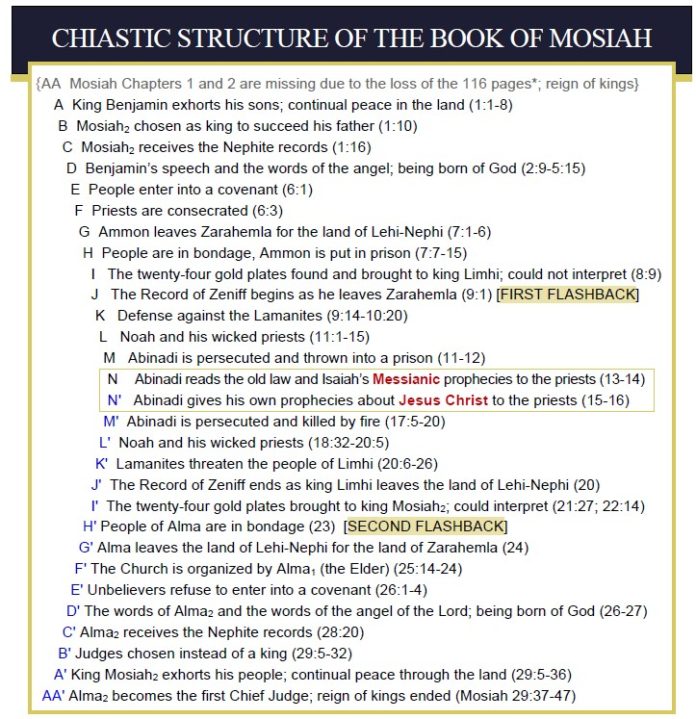“John W. Welch, Editor-in-Chief, BYU Studies, has written and edited numerous wonderful books and articles about the Book of Mormon. He discovered chiasmus in the text and has offered many valuable insights about historicity of the text, particularly related to the Old World setting.” Moroni’s America page xii-xiii

“The Book of Mosiah is organized into a complex chiasmus which focuses on the Messianic teachings of the prophet Abinadi and places emphasis on the powerful teachings of king Benjamin and king Mosiah (Welch, John W., “Chiasmus in the Book of Mormon,” BYU Studies, Vol. 10, No. 1 [1969], 13). The prophet and historian Mormon accomplishes this by using two flashback sequences. The FIRST FLASHBACK (J through J’) is inherently chiastic, so Mormon puts it in the center. The rest of the account, if told in chronological order, would not be chiastic. Mormon uses a SECOND FLASHBACK (H’ through C’) to create a chiastic structure. This complex narrative demonstrates a deliberate effort by Mormon to use the parallel structure common to Hebrew writing as also found in the Bible. This is further evidence that
both scriptural witnesses of Christ—the Bible and the Book of Mormon—were written by prophets inspired of God.” Annotated Book of Mormon by David Hocking and Rod Meldrum page 140
Below is from Moroni’s America by Jonathan Neville pages 26-28
The framework for Book of Mormon geography is set forth in Alma 22, in which Mormon describes the way the land was divided between the Nephites and the Lamanites. He is writing several hundred years in the future, looking back on the events as a historian providing an overall perspective.
Alma 22 can be confusing because we are not accustomed to the method Mormon used to describe the various lands. Plus, the current chapter and verse divisions make the text a little more confusing than it should be. (In the next chapter I suggest two changes that would help, although I realize we can’t change the chapters and verse at this point.)
One point to keep in mind is that Mormon describes the overall picture of Nephite and Lamanite lands in the first section, then he focuses on a particular region of Nephite territory (Bountiful and Desolation) before coming back to summarize the overall picture.
He begins in verse 27, where he gives a general outline of the Lamanite King’s territory. Here is how verse 27 appeared as originally translated by Joseph Smith and recorded by Oliver Cowdery, without punctuation:[i]
And it came to pass that the king sent a proclamation throughout all the land amongst all his people who were in all his land who were in all the regions round about which was bordering even to the sea on the east and on the west and which was divided from the land of Zarahemla by a narrow strip of wilderness which ran from the sea east even to the sea west and round about on the borders of the seashore and the borders of the wilderness which was on the north by the land of Zarahemla through the borders of Manti by the head of the river Sidon running from the east towards the west and thus were the Lamanites and the Nephites divided.
As you can imagine, this long sentence has been interpreted in many different ways. For example, the meaning of the passage changes completely depending on what each clause beginning with the word which modifies.
When I analyzed this passage, I considered what others had written.[ii] But then I wondered why Mormon wrote it this way, and how he thought it would be intelligible to his future readers.
(Actually, I wondered why Mormon didn’t just include a map on the plates. Presumably, as a military leader, Mormon used maps. If a picture is worth a thousand words, it seems like a map would be worth a thousand words of description. Of course, it is possible that Mormon did draw a map on the plates, and that Joseph saw it, but neither he nor any of the Three or Eight Witnesses mentioned it. If there was a map engraved on the plates, we don’t have a copy of it. The only things traced from the plates were the characters that Martin Harris took to Charles Anthon and the other scholars.[iii])
Although we don’t have a map from the plates, the text works well enough when we combine the other elements we’ve been given.
A key point to understanding Alma 22:27 is the ancient poetic form of chiasmus that is also found in the Hebrew Bible.
Chiasmus is an inverted parallel structure in which a series of thoughts are repeated in reverse order. The structure helps convey meaning, serving a function similar to modern punctuation. (Chapters 27 and 28 explain chiasmus and its application to the geography passages in more detail.)
It should not be surprising that Mormon and other Book of Mormon authors would use chiasmus, since they lived in a Hebrew culture and knew the language. In fact, it would be more surprising if they didn’t use chiasmus.
It is helpful to re-format chiastic passages so the parallel structure is more apparent. When formatting parallel structures in a text, scholars commonly put a capital letter at the beginning of each line to clarify the correspondence between the two branches of the chiasm.
A simple chiasmus would look something like this:

There are several passages in the text that use this structure. Here is an example Don Parry offers from Mosiah 2:56.

Mormon constructed Alma 22:27 and subsequent verses in discreet lines of text and phrases that make sense when viewed in this chiastic—or parallel—format. Chapter 28 includes a step-by-step analysis of the chiastic format. Here I am merely summarizing it.
Parallel terms are underlined for convenience. In my proposed structure below, I’ve also bolded the word which because of its importance to the structure and meaning of the passage. In this format, each of the which clauses modifies the original focus of the passage—the extent of the king’s land. Together, they describe an oval or a rectangle. This clarifies the meaning of the text and produces a general overview of the geography in The Book of Mormon.
Alma 22:27—Chiastic format
“And it came to pass that the king sent a proclamation throughout all the land

Here’s how this verse looks in graphic form:
NOTES
[i] The earliest manuscript we have for this section of the text is the printer’s manuscript, which shows punctuation added by the printer. Placement of punctuation makes a difference in the meaning; because punctuation was added after Joseph dictated the words, punctuation reflects someone’s interpretation of the text. Disregarding the punctuation offers a chance for an unimpeded interpretation.

[ii] In the year 2000, John Sorenson published Mormon’s Map, an overview of what The Book of Mormon text says about geography. He writes, “The nearest thing to a systematic explanation of Mormon’s geographical picture is given in Alma 22:27-34… He [Mormon] must have considered that treatment full and clear enough for his purposes, because he never returned to the topic.”[1] Sorenson takes the approach of creating an abstract map based on The Book of Mormon text, and then seeing if it fits in a real-world location. I agree with Sorenson about the importance of Alma 22, as well as the utility of creating an abstract map and finding a fit in the real world.
However, Sorenson’s analysis of Alma 22 seems to be influenced by the Times and Seasons article published on 1 October 1842, which declares that the Nephite city of Zarahemla “stood upon” “Central America or Guatimala [sic].” Sorenson cites this passage from the Times and Seasons, although he recognizes the “fact that the geography question had not been settled authoritatively.”[1] In Mormon’s Codex, Sorenson relegates the Times and Seasons articles to a footnote in support of his unequivocal conclusion: “Joseph Smith became convinced in the last years of his life that the lands of the Nephites were in Mesoamerica.”[1]
Sorenson’s assumptions about Central America lead him to a preconceived concept of Book of Mormon geography; i.e., a narrow neck of land between two larger land masses. Perhaps he felt somewhat bound by the Times and Seasons articles and his inference that Joseph Smith agreed with them. As such, Sorenson’s work could be viewed as an effort to vindicate the Prophet’s words.
[iii] Joseph Smith copied characters from the plates for Martin Harris to take to scholars, but the whereabouts of that document is unknown. There are three existing documents that contain characters from the plates that may have been copied from the paper Joseph prepared. See http://bit.ly/Moroni10.






